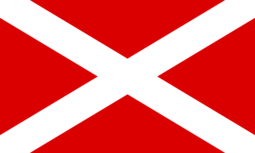Flag of Gascony
 | |
| Name | Lo Sautèr (the Saltire) |
|---|---|
| Use | Civil |
| Proportion | 3:5 |
| Adopted | 12th century (1188?) |
| Design | A redfield with a white diagonal cross that extends to the corners of the flag. In Blazon, , a saltire Argent. |
The Flag of Gascony represents the region of Gascony, located in France. The legend says that this flag appeared in the time of Pope Clement III (term 1187–1191) to gather the Gascons during the Third Crusade (12th century), but no proof of this allegation has yet been found. The Chronica of Rogeri de Houedene,[1] often taken as a proof for the creation of this flag, only mentions the crosses taken by the crusaders of three nations: the French (a red cross), the English (a white cross) and the Flemish (a green cross).
That flag contains the St Andrew's cross, the patron saint of Bordeaux and the red color of the Kingdom of England, which reigned over Gascony from the 12th to the mid-15th century.
After the end of the Hundred Years' War (1337–1453), the flag went out of use and was never replaced.
A modern blazon (blue and red with sheaf of wheat and lion) was created in Versailles by the judge of weapons' cabinet (chief of protocol) of French king Louis XIV in 1697–1709, in order to add symbolically the province to the French royal coat of arms.[2]
The contemporary return of the historic flag of Gascony is ought to convey identity and values which make of this province a land of "douceur de vivre" (sweetness of life): soft climate, authenticity of relationship, conviviality, good wines and art of dining.
For more information, see the Gascony page.
References[]
- ^ Chronica magistri Rogeri de Houedene. Vol. 2 / ed. by William Stubbs, 1868-1870, p.335 - http://gallica.bnf.fr/ark:/12148/bpt6k50282q/f442.image
- ^ https://commons.wikimedia.org/wiki/File:Blason_province_fr_Gascogne.svg?uselang=en
- 12th-century establishments in France
- Flags of France
- Third Crusade
- Red and white flags
- History of Nouvelle-Aquitaine
- History of Occitanie
- Gascony